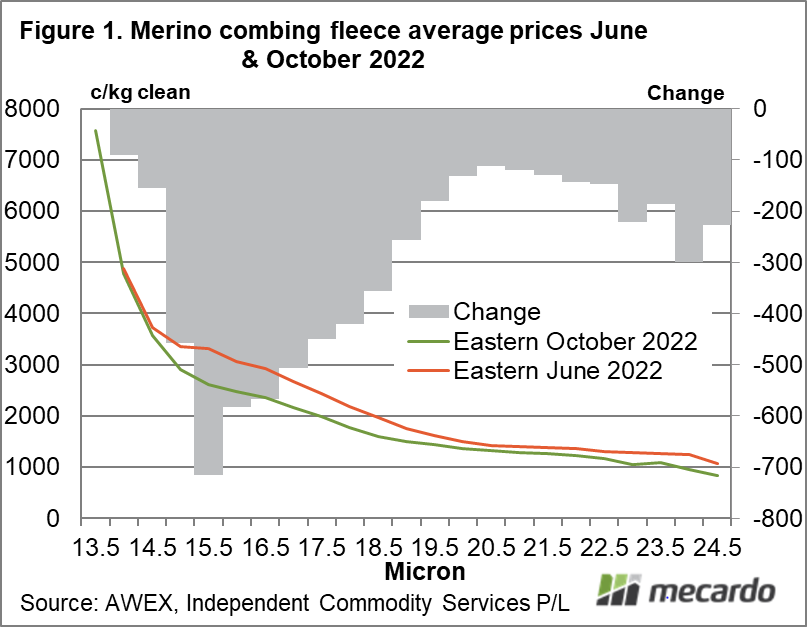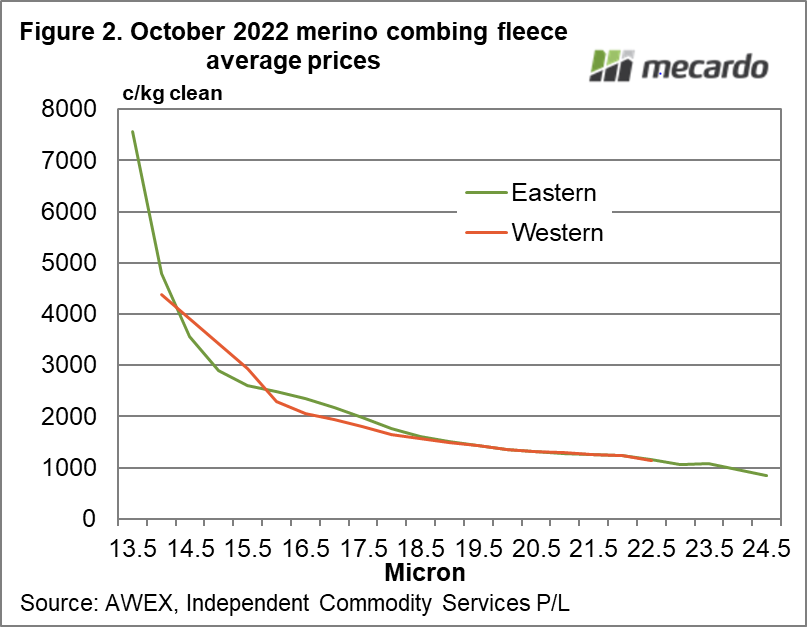With fine merino premiums under downward pressure, after an extended period at high levels, it is timely to look at the merino micron price curve. Some fine wool breeders have the measurements and capacity to split clips up by micron, so the price curve is an important piece of information for that process.
Fibre diameter has been the dominant factor in merino prices since the development of the modern greasy wool market in the early 1980s, although the actual contribution of fibre diameter does vary. In the absence of any formal analysis in recent years it would be safe to say micron has been extremely dominant in recent years even for cardings.
Figure 1 shows the eastern price curves for merino combing fleece for October to date and June as well as the change in price (bars) running from 24.5 down to 13.5 micron. 15-16 micron has lost 500-600 cents in price compared to around 120 cents for 21 micron. By default the price premiums for 15-16 micron have shrunk markedly with 17 to 19.5 micron premiums also shrinking, at a slower rate as the micron broadens.
In Figure 2 the current October (to date) price curve for merino combing fleece is shown for both the eastern selling centres and Fremantle (western). Note that the western price curve matches the eastern price curve very closely down to 18.5 micron. Below 18.5 micron the western price does vary from the eastern curve but in the main tracks it upwards.
To look for inflection points in the curves Figure 3 shows the half micron changes in price for the eastern and western curves from Figure 2. In the east there is a steep inflection point at 15.5 micron, while in the west there is one around 16.5 micron. Given this price structure it will pay to split wool across these inflection points, with the rider that faults such as low staple strength, high vegetable fault, water stain and heavy unscourable colour will very likely diminish any micron premiums greatly. Figure 3 also show there is still a weak inflection point around 20 micron. This is the inflection point which has been getting weaker with the change (fall) in prices shown in Figure 1.
Finally Figure 4 is added to remind us where the volumes (October to date) in the market are for the different micron categories. It is also a way of explaining why price premiums for sub 15.5 micron wool remain high, there is little volume. The big merino categories by volume in the Australian clip currently are 18.5 through 20.5 micron.
What does it mean?
The fall in fine wool prices, in recent months, has weakened the inflection point in the merino price curve which was around 19-20 micron. However a notable inflection point still exists around 15.5 micron in the eastern centres, offering some opportunity to split wool which has been tested either side of this micron. In the west there looks to be a similar inflection point around 16.5 micron.
Have any questions or comments?
Key Points
- The 15 to 16 micron categories have suffered the biggest price falls since June.
- Micron price premiums for 15 micron and finer (compared to 19-21 micron) have shrunk accordingly.
- A strong inflection point remains around 15.5 micron in the eastern markets (16.5 micron in the west) which offers an opportunity to split wool up by micron.
Click on figure to expand
Click on figure to expand
Click on figure to expand
Click on figure to expand
Data sources: AWEX, ICS, Mecardo.














